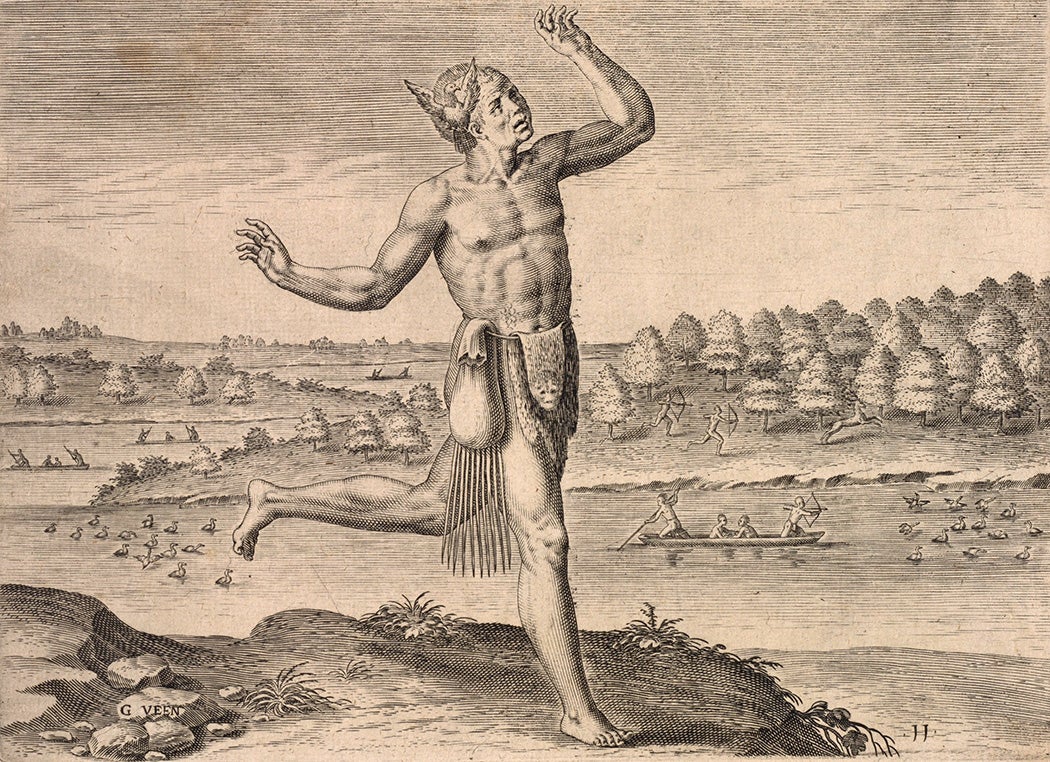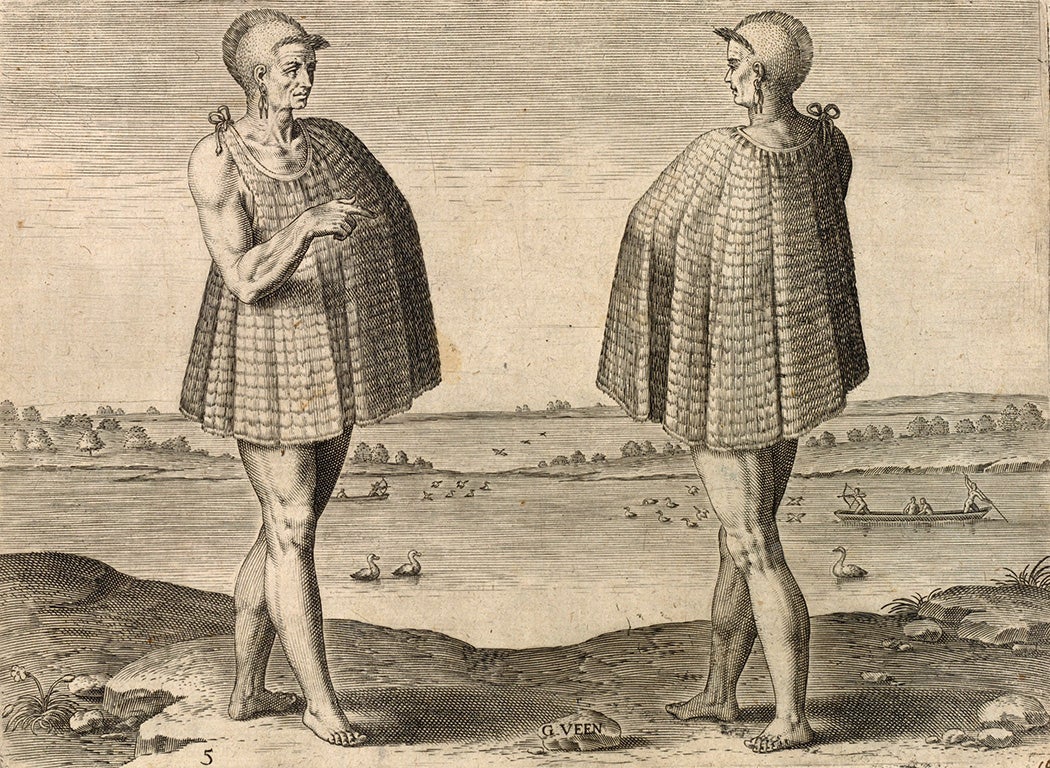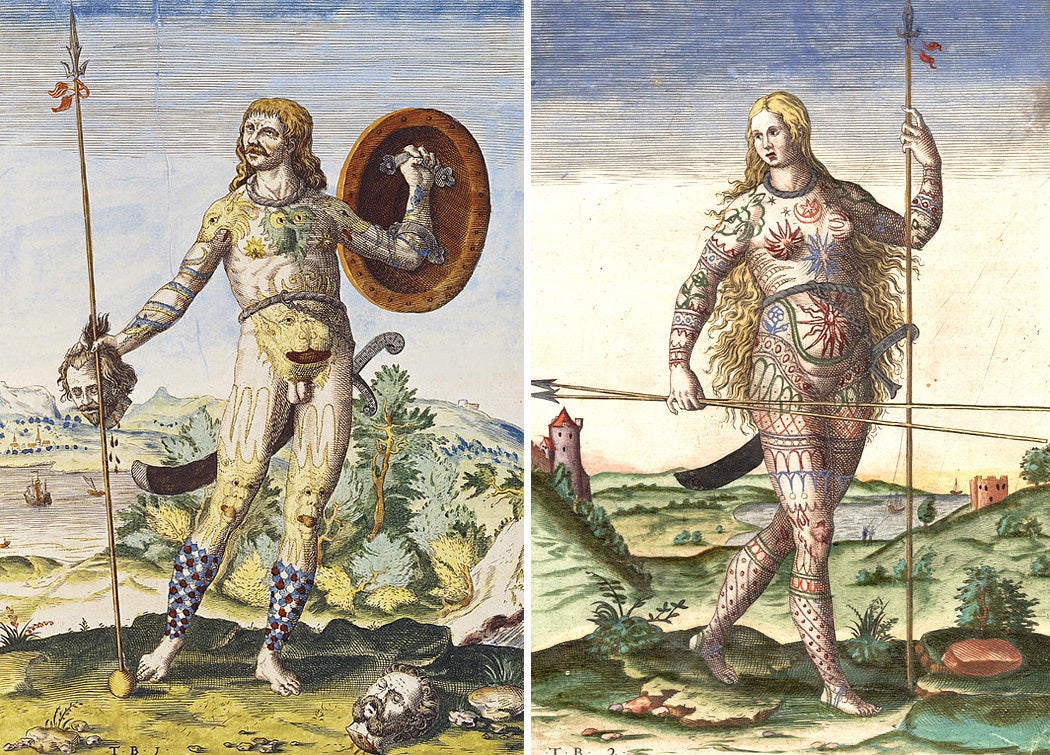When the astrologer Simon Forman went to the theater in 1611, one of the plays he saw depicted a powerful empire moving into the west to conquer—and, supposedly, elevate—a group of barbarians who lived at the world’s periphery. Forman’s thoughts at the Globe Theater may have turned to “no act of common passage, but / A strain of rareness” as he watched this colonial drama unfold. For Londoners, such New World concerns had been top of mind for more than a generation. Jamestown had been founded in Virginia four years before. And Sir Walter Raleigh’s had attempted to establish a colony in what would be North Carolina in 1585, an attempt followed by the infamous “lost colony” of Roanoke, in 1587. Those earlier colonies were part of Queen Elizabeth’s tentative gestures toward American colonization, and though they were largely unsuccessful, the discoveries made, and the imperial justifications proffered, by figures like Raleigh, his half-brother Humphrey Gilbert, and Martin Frobisher, were part of the public consciousness. These themes of conquest would have seemed especially pertinent as the English once again tried to establish a toehold across the Atlantic, under the reign of the new monarch, James I. Yet as familiar as this story of a civilizing empire’s sojourns among a savage people may have seemed to a Jacobean audience, Forman’s basic plot-recounting in his diary about William Shakespeare’s “story of Cymbeline, king of England, in Lucius’ time,” with its tale of faith and culture that “came with the Romans into England,” make it clear that, even then, the conversations surrounding “civilization” and “savagery” could be complicated, nuanced, self-serving, and ironic.
Weekly Newsletter
Forman’s is one of the few contemporary accounts of Shakespeare’s staging, and he says little about how the Romans were differentiated from the Britons in Cymbeline. That doesn’t mean that the period wasn’t replete with depictions of the ancient Britons and Picts, as well as their cousins, the contemporary Irish and Scots, against the former of whom the English were engaged in a genocidal campaign. Furthermore, as is made clear by James E. Doan in New Hibernia Review/Iris Éireannach Nua, those colonists (off in distant Virginia, while Forman enjoyed Cymbeline) “made early ethnological comparisons between the Irish and the native American cultures.”
Keith Pluymers argues the same thing in Environmental History, writing that “images of the Algonquians and Virginia’s landscape closely resembled Ireland” in colonial depictions of America. Such language was deployed, in part, because conquerors like Raleigh and Gilbert were veterans of the ethnic cleansing campaigns in Ulster that established the brutal plantation system in Ireland.
Such language was also used because of the shared Celtic origins of the Britons and the Irish, and perceived similarities between both to the Algonquin Indians of the Chesapeake and Potomac region. A rhetoric of anxiety supplied self-satisfied justifications for colonization. The English nervously considered their own origins in plays like Cymbeline, asking what the importance was of appearance and culture in the constitution of a people. Clothes are not incidental in Cymbeline, nor were they in the consolidating racial discourses that justified English incursions into Virginia (and Ireland). In Shakespeare’s play, a character switches allegiance from the Romans to the Britons with the declaration that “I’ll disrobe me / of these Italian weeds and suit myself / as does a Briton peasant.” More than perceived phenotypical difference, it was Algonquin clothes (or, as the English saw it, the lack thereof) that reminded them of the Irish, who were the first victims of English imperialism. It also reminded them of their own ancestors, supposedly civilized and Christianized by the Romans. The propagandistic import of the rhetoric that described the Indians as being similar to the ancient Britons was clear: as we once were, so are you now. And as the Romans made us, so shall we make you.
* * *
Nowhere is this clearer than in the remarkable ethnography A Brief and True Report of the New Found Land of Virginia, written by the astronomer and mathematician Thomas Harriot, with engravings by the Flemish illustrator Theodor de Bry. The illustrations are based on watercolors made on site by John White. Harriot’s text provides relatively sober description of North Carolina’s flora and fauna (all of English America was then “Virginia”), surprisingly objective and sympathetic accounts of Algonquin anthropology and linguistics, and details on animal and botanical husbandry in the New World.
“There have been diverse and variable reports,” Harriot writes, “with some slanderous and shameful speeches bruited abroad by many that returned.” A Brief and True Report of the New Found Land of Virginia is both Harriot’s attempt to correct that record as he sees it, but also to provide incentive for investors to keep funding Roanoke. Not only was Harriot a cagey marketer, he was also a stolid observer of the natural world, having distinguished himself in navigation, astronomy, and mathematics. In its fascination with objective data, his treatise has remained invaluable even today for anthropologists studying the Algonquin at the moment of contact.
Most evocative of all in this respect are the illustrations that accompany Harriot’s text. While White’s original watercolors (an unusual medium for an illustrator to work in at the time) were only first exhibited in the twentieth-century, readers would have learned about the Algonquin from de Bry’s engravings. The Flemish lithographer had never actually been to America himself. Charlotte Ickes argues in American Art that, as a result, “De Bry’s engravings… [were] informed by certain European aesthetic conventions as well as the taxonomic logic of nascent ethnographic inquiry.” Consider an image of an Algonquin man made by de Bry:

Ickes writes that de Bry’s “figures often stand in a generic no-place, and several of their stances derive from earlier sources.” Despite Harriot’s meticulous observations concerning North Carolina’s terrain, de Bry has opted to place his figure in an idealized and recognizably European landscape. The rolling hills and pines evoke the Scottish midlands as much as the Carolina Piedmont. Even more stylized is the brave himself, who in his affected position and with his seemingly winged helmet, bears far more similarity to the pagan god Mercury than he does to an Algonquin youth. If not for the fringed loincloth, a viewer might assume that they were looking at an image of Hermes.
Or examine both an original by White and de Bry’s version of that same image, both of which depict an Algonquin religious ritual:

De Bry’s engraving (the lower one) has more allegory than verisimilitude about it. White’s watercolor feels like anthropology: the rough circle on which the Algonquin dance is clearly made from dust kicked up from their feet, in contrast with de Bry’s perfect circle. Where White presents an undifferentiated wooden column that the Indians encompass, de Bry places a face at the top of the totem, so as to make its status as an idol clearer to viewers. In comparing the figures embracing near the base of the column, de Bry’s version more clearly delineates them, and in pose they look like nothing so much as the iconic three graces of classical sculpture. Naturalistic poses from White are tweaked, so that de Bry’s figures are more stylized, and the engraver has added (what appear to be) bushels of wheat absent in the original, perhaps to give the familiar sense of European paganism. To that end, the omission of color from de Bry’s image erases complexion, so that his picture takes on a quality of distinctly European “universalism,” as opposed to the ethnographic particularism of White’s painting. More than an anthropological account of Algonquin rituals from eastern Carolina, de Bry’s engraving calls to mind the enactment of a Celtic Mayday dance about the Maypole, the women and men of the Algonquin village looking like Lords of Misrule from Carnival.
Despite de Bry’s allegorizing, David B. Quinn notes in The William and Mary Quarterly that Harriot “did much to describe and explain the natural resources and the inhabitants of a part of eastern North America to English readers.” A Brief and True Report of the New Found Land of Virginia was translated into several languages. It “reached a wide European audience and built up a substantial segment of western knowledge of the Americas.” Somewhat fluent in the Indian language of his Native American associates, Harriot’s notes on the Algonquin constitute a surprisingly objective attempt at comprehending the culture, folkways, tribal government, and religion of the Native Americans.
However, Harriot shouldn’t be thought of as advocating any kind of modern multicultural tolerance. Writing in The North Carolina Historical Review, Michael Leroy Oberg explains that Raleigh’s reason for sending Harriot and White to Roanoke was not knowledge for its own sake, but rather to “accumulate enough information about Algonquian culture and society to incorporate the natives into the Anglo-American, Christian New World empire that he hoped to plant in Virginia.” Harriot’s purposes, in other words, were imperialistic, and his study was to aid in colonization, writing that whereby “it may be hoped, if means of good government be used, that… [the Indians] may in short time be brought to civility and the embracing of true religion.” (In this respect, as Karen Ordahl Kupperman notes in The Historical Journal, some advocates for English imperial expansion “felt the Indians would be easier to civilize than the Irish.”)
Early relations with the Algonquin were relatively peaceful at Roanoke and Jamestown, yet as English aggression toward the natives increased, the language used to describe them became increasingly similar to that used against the Irish. Doan writes that “images of Ireland and America as portrayed to potential colonists were strikingly similar.” Comparisons of “agricultural technology… forms of dress, settlement and house types” were made between the Algonquins and the Irish, so as to “justify the often brutal military conquest and subsequent economic and political subjugation and exploitation of the ‘natives.’” These rhetorical comparisons were obvious in the seventeenth century, as England’s wars against both the Irish and the Indians became more genocidal.
But even in Harriot’s work, published earlier, the presumed similarities between the disparate groups are still evidenced. Harriot writes of Algonquin hunting techniques that they used “poles made sharp at one end, by shooting them into the fish after the manner as Irishmen cast darts,” which Doan explains may have referred to traditional Irish throwing darts, known as woodkerns. John Smith made similar observations, claiming that the deerskins worn by the Powhatan Indians were “in fashion from the Irish mantels,” a claim seemingly substantiated in an engraving of de Bry’s, which depicts two Algonquin wearing chitons that appear almost tartan in their checkered design:

Similarly, Doan quotes the English historian William Camden, who as early as 1562 would describe the visit of the Irish chieftain Shane O’Neil to the court of Elizabeth as arriving with a “guard of ax-bearing galloglasses, bareheaded, with curled hair hanging down, yellow surplices dyed with saffron or man’s stale [urine], long sleeves, short coats, and hair mantles. Whom the English people gazed at with no less admiration that nowadays they do them of… America.” Such were the Irish “stock images that writers could apply to the newly hostile Virginia,” as Pluymers writes.
* * *
Perhaps it’s obvious that the English, or any imperialist power, would have a vested interest in making comparisons between divergent and unconnected groups who are both being colonized, whether those depictions are positive or negative. What’s more curious are the ways in which the Algonquin were compared to not just the contemporary Irish, but also to the ancient Britons themselves, and to the associated groups like the Picts, whom the English warily eyed with martial pride—and anxiety over their perceived Celtic origins.
De Bry writes, in a gloss to one of his images from A Brief and True Report of the New Found Land of Virginia, that “the inhabitants of the great Bretannie have been in times past as savage as those of Virginia.” English animosity towards the Celtic speaking peoples of Scotland and Ireland had to be awkwardly contextualized in terms of British origins. Both the Welsh Tudors and the Scots Stuarts uneasily appropriated their own Celtic origins for nationalistic purposes while simultaneously oppressing speakers of contemporary Gaelic languages. And pride over quasi-mythic figures, from Arthur to Boudica, had to be reconciled with the reality that they would have bared more similarity to the Irish, Welsh, and Scots than to the sixteenth and seventeenth-century English.
Part of this mental reconciliation was done by justifying colonialism with its benefits, arguing that as the English had once received the “gifts” of civilization and Christianity from the Romans, as depicted in Cymbeline, so that the “English would give the Indians the advantages of a richer culture, a more advanced civilization, and, most importantly, the Christian religion,” as Doan writes. Thus, comparisons of the Algonquin to not just the Irish, but to the ancient Britons, served an even more obvious purpose: as the Romans lifted us up, so shall we lift you up.
Such is the clear reasoning behind the strangest set of engravings included by de Bry in the Brief and True Report, a grouping with no precedent in White’s original illustrations. Included alongside the representations of Indians, de Bry presents engravings of the ancient Picts, who populated Great Britain at the time of the Roman invasion. Readers are to draw a clear and obvious connection between the Britons and the Algonquin:

Like Shakespeare’s character in Cymbeline trading his Roman armor for British apparel, so do clothes (or lack thereof) make the woman and man in de Bry’s engraving. The figures are covered in tattoos, with torques around their necks and uncut hair falling loose about their shoulders. When de Bry’s Pictish woman and man are reproduced without colorization, their pale skin and blonde hair are erased. They look (by de Bry’s logic) more Algonquin than British. An arresting detail in the Pictish man’s hand and at his feet, as the warrior clutches the decapitated head of some opponent, presumably an invader against whom he’s defending Britain. What’s telling is that this unfortunate “Roman’s” head doesn’t look particularly ancient; rather de Bry presents the Pict’s victim with the contemporary and popular Elizabethan style of a van Dyck. Viewers aren’t to see the decapitated man as Roman, but rather as English; just as the warrior isn’t quite a Briton or an Indian, but something in between.
De Bry’s Picts aren’t people, but rather arguments. They embody a claim that what’s past can be the present, and what’s present will be the future. A convenient argument, for in conflating the Britons, the Irish, and the Algonquin with one another, the English can become the Romans marching into Britain with the supposed virtues of civilization. In this fantasy, the English are thus both perpetrators and victims, both beneficiaries and distributors of benefits. Anthropology is translated into the language of propaganda.
Editor’s note: This story has been edited to avoid the use of a potentially offensive term for a native American.
![Travels through Virginia. [From Theodor de Bry's 'America', Vol. I, 1590, after a drawing of John White].](https://daily.jstor.org/wp-content/uploads/2019/12/the_construction_of_america_in_the_eyes_of_the_english_1050x700.jpg)






